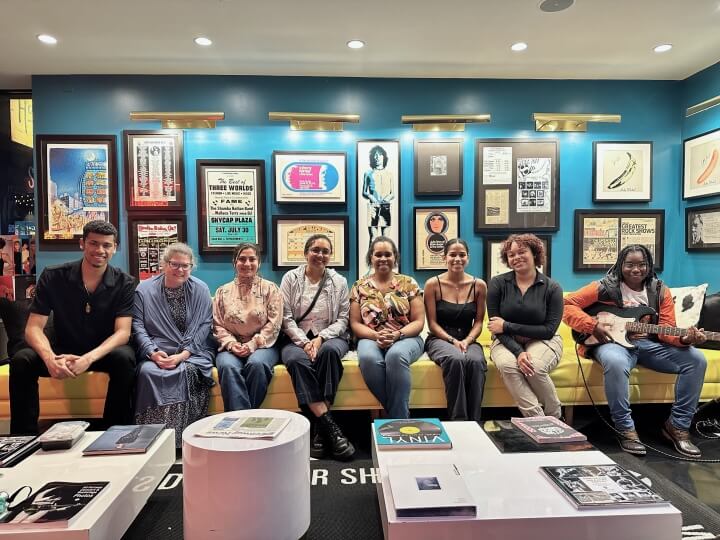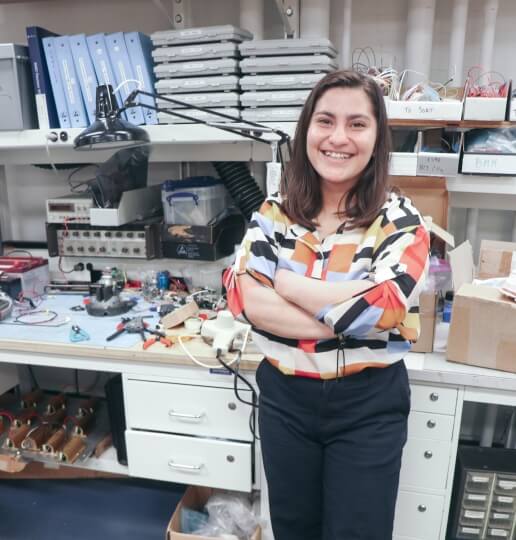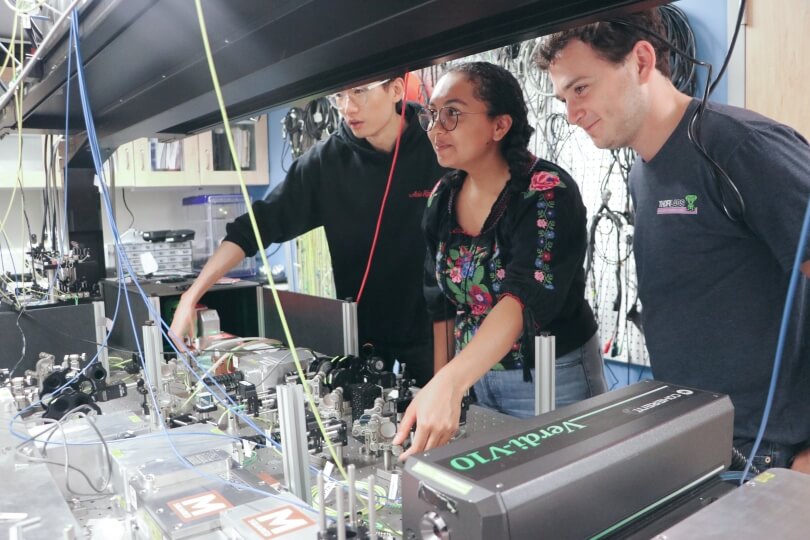News
Five SEAS post-baccalaureate students with staff members Edward Alexander, Kathryn Hollar and Paula Nicole Booke
The graduate and undergraduate student experience isn’t the same. Undergraduates spend the majority of their four years in classrooms. But for graduate students — especially those pursuing PhDs in engineering and applied sciences — most of the work is in the lab.
The focus on laboratory research can make pursuing advanced degrees feel daunting for some students.
“I’d always had a love for math, science and experimentation, but when COVID happened, they shut down the school, so I wasn’t able to do any hands-on experiments, “ said Shekinah Newson.
After graduating in 2021, Newson joined the inaugural cohort of post-baccalaureate students at the Harvard John A. Paulson School of Engineering and Applied Sciences (SEAS). The post-baccalaureate program, offered through the SEAS Office of Diversity, Inclusion, and Belonging and Office of Education Outreach and Community Programs, acts as a bridge from undergraduate to graduate school. The program allows students to gain laboratory research experience with SEAS faculty, while continuing to take courses that will prepare them for their graduate studies.
Post-baccalaureate students typically stay for 1-2 years, but have the option to stay on for a third. So far six students have completed the program, five of whom have gone onto graduate school.
“I’m super glad I did it, because now I’ve honed in the research skills that I started to develop as an undergraduate,” said Maggie Vallejo, a former environmental science and engineering undergraduate concentrator at SEAS. “I definitely think more like a researcher, and I better understand that research isn’t linear.”
Vallejo’s undergraduate advisor was Jim Anderson, Philip S. Weld Professor of Atmospheric Chemistry, and she returned to the Anderson Research Group for her post-baccalaureate studies. Her senior capstone project involved predicting power losses in solar cells aboard stratospheric aircraft, and as a post-baccalaureate researcher, she transitioned to analyzing lithium-ion battery cell performance.
Post-baccalaureate student Maggie Vallejo in the lab of Jim Anderson, Philip S. Weld Professor of Atmospheric Chemistry
“During the application process, I made sure Professor Anderson was OK with me just staying in his lab,” she said. “I was interested in the work I was already doing, and I knew the people in the lab, so I figured why not just stay.”
Vallejo spent both years of her program with the same professor, but that isn’t required. The program is meant to help students focus their academic goals, and sometimes that focus clarifies that the lab a student started in isn’t exactly what they want moving forward. Dawn Bordenave, another member of the inaugural cohort, spent each of her first two years in different labs before settling into the lab of Joanna Aizenberg, Amy Smith Berylson Professor of Materials Science and Professor of Chemistry & Chemical Biology.
Bordenave is part of Aizenberg’s research into the improvement of ventricular catheter design for treatment of hydrocephalus, a potentially deadly disorder in which fluid builds up in the cavities deep within the human brain. Her specific part of the project is to develop low-cost methods of constructing the catheter in the lab, making it much easier to physically test new designs before beginning clinical trials.
“After spending time in other labs, I realized that I wanted to do something different that was a little closer to my goal of designing medical devices,” Bordenave said. “The program is very flexible. If the research, lab or mentor you start off with isn’t close to what you want and you want to change, that’s definitely an option. The Aizenberg Lab was the best fit for me.”
Newson, who completed the program last month, worked in the Harvard Biodesign Lab, led by Conor Walsh, Paul A. Maeder Professor of Engineering and Applied Sciences, as well as the lab of Michael Brenner, Michael F. Cronin Professor of Applied Mathematics and Applied Physics and Professor of Physics. With Walsh, she worked on the soft robotics toolkit, an educational package for teaching robotics to younger students. With Brenner, she helped developed a non-invasive method to measure range of motion
“This innovative educational resource empowers people to learn about robotics through engaging, hands-on activities,” Newson said. “To be able to build a toolkit that allows a child to both play and learn at the same time is amazing. I wish I had something like that when I was growing up.”
Newson, Bordenave and Vallejo will all be leaving SEAS for graduate programs at other universities. Newson will pursue a master’s degree in robotics at Boston University, and Bordenave and Vallejo are both heading to Cornell University: Bordenave for a master’s degree in biomedical engineering, Vallejo for an M.S./Ph.D. program in civil and environmental engineering.
“It was fantastic having Shekinah as part of our research group,” Walsh said. “She got involved in a number of projects, including one focused on using soft robotics in education and STEM outreach. It is very exciting that she will be going on to do an MS in robotics at BU as a next step. Her passion for learning and growing her engineering skill set has been a great example for us all.”
Eva Langenbrunner joined the program last fall and will be back to work in the Harvard Microrobotics Lab, led by Robert Wood, Harry Lewis and Marlyn McGrath Professor of Engineering and Applied Sciences. She’s developing materials that can fold into origami-like shapes using soft robotic actuators.
“Post-baccalaureates programs are really great because they teach you how to be a successful grad student,” she said. “The program goes over how to properly write research articles, which is something no one in undergrad teaches you how to do, but then you get to grad school and they expect you to know it. The biggest thing I learned here was how to structure a research project from beginning to end.”
Post-baccalaureate student Katie Barajas working in the lab of Marko Lončar, Tiantsai Lin Professor of Electrical Engineering and Applied Physics at SEAS
Langenbrunner will be joined by new post-baccalaureate Jonathan Chinana, a Navajo Technical University (NTU) graduate who first came to SEAS for the Research Experience for Undergraduates program in the summer of 2022. Michael Nelwood, another NTU graduate, finished his post-baccalaureate studies in the lab of Jennifer Lewis, Hansjörg Wyss Professor of Biologically Inspired Engineering. He’s now working as a lab tech in the Lewis Lab.
Katie Barajas has spent the last two years with the Harvard Quantum Initiative, working in the lab of Marko Lončar, Tiantsai Lin Professor of Electrical Engineering and Applied Physics. She’ll continue with the Lončar Group as an applied physics Ph.D. student this fall. Her research focuses on the fabrication of nanostructures in specially lab-grown diamonds. These diamonds have a silicon atom implanted in place of two carbon atoms. These defects are called “silicon vacancy centers,” and they could potentially be used to transmit information in a quantum computer.
“It wasn’t until late in my undergrad career that I learned about the field of quantum optics. If I wanted to pursue a degree in that field, I needed more research experience,” she said. “That persuaded me to do the post-baccalaureate program. I’m in a much better place than when I was coming out of undergrad. This program has given me the confidence to say I can be a scientist and pursue scientific research, and that’s a testament to the people I’ve worked with.”
Topics: Academics, Applied Physics, Bioengineering, Diversity / Inclusion, Environmental Science & Engineering, Materials Science & Mechanical Engineering, Optics / Photonics, Quantum Engineering, Robotics
Cutting-edge science delivered direct to your inbox.
Join the Harvard SEAS mailing list.
Press Contact
Matt Goisman | mgoisman@g.harvard.edu





